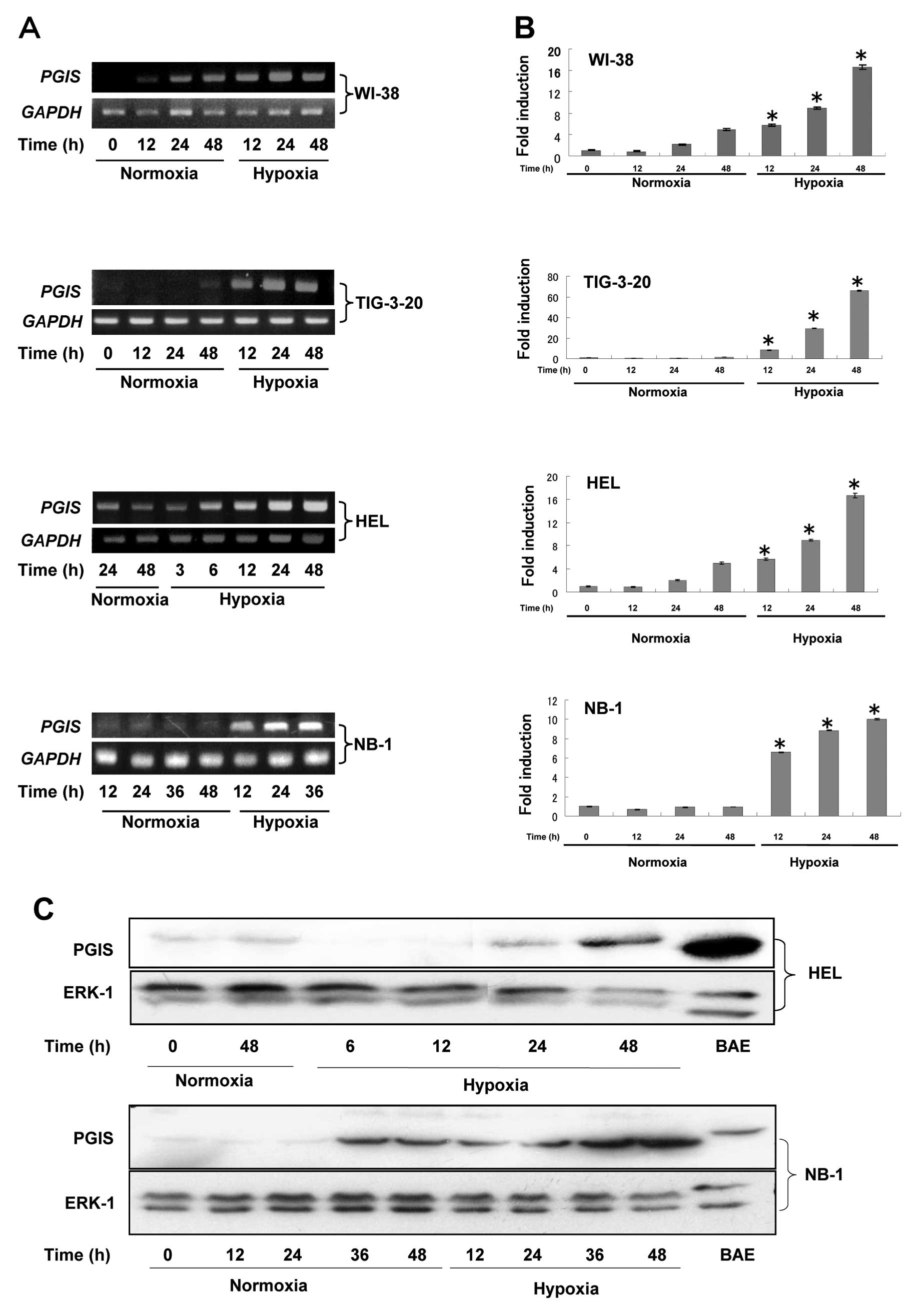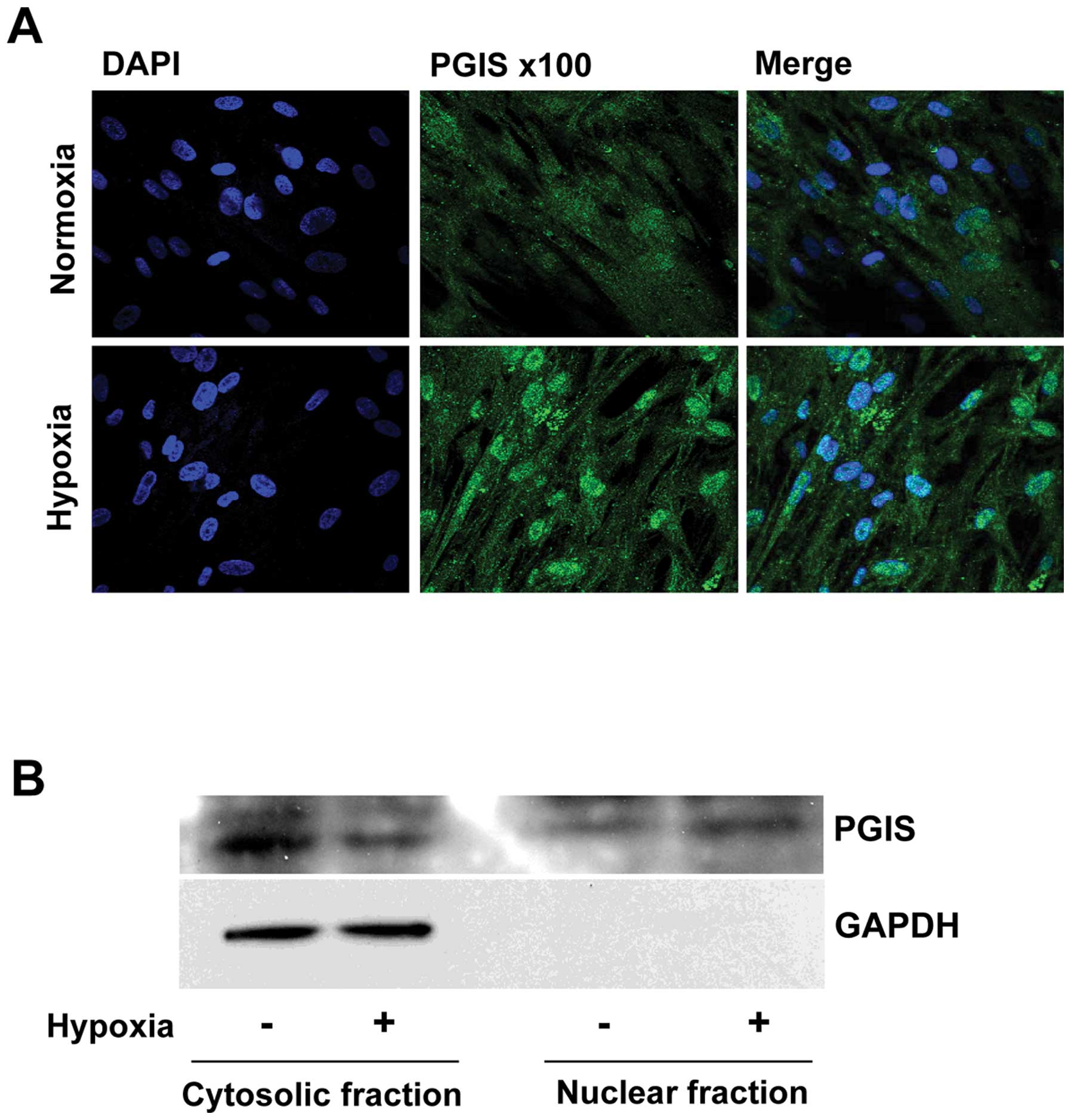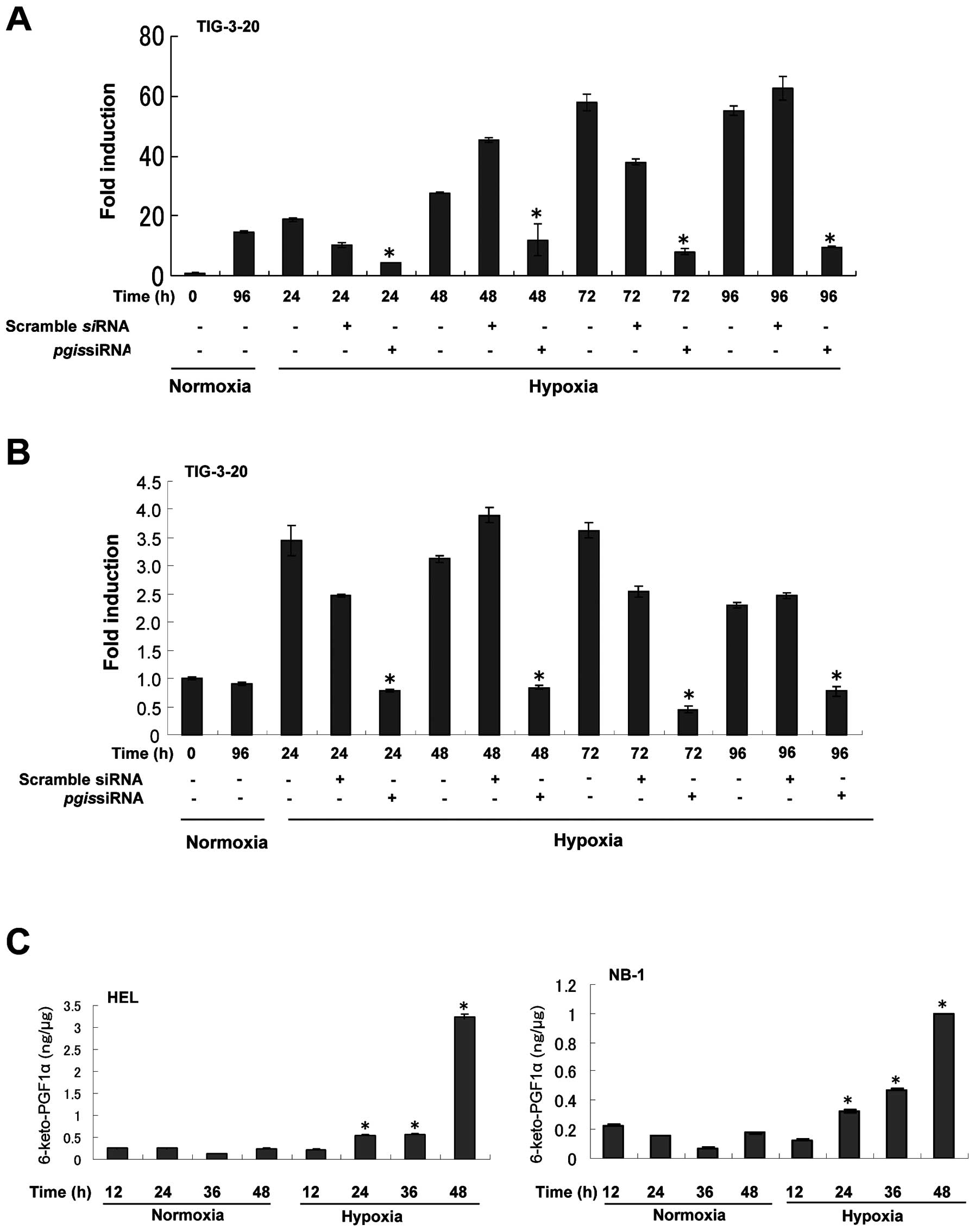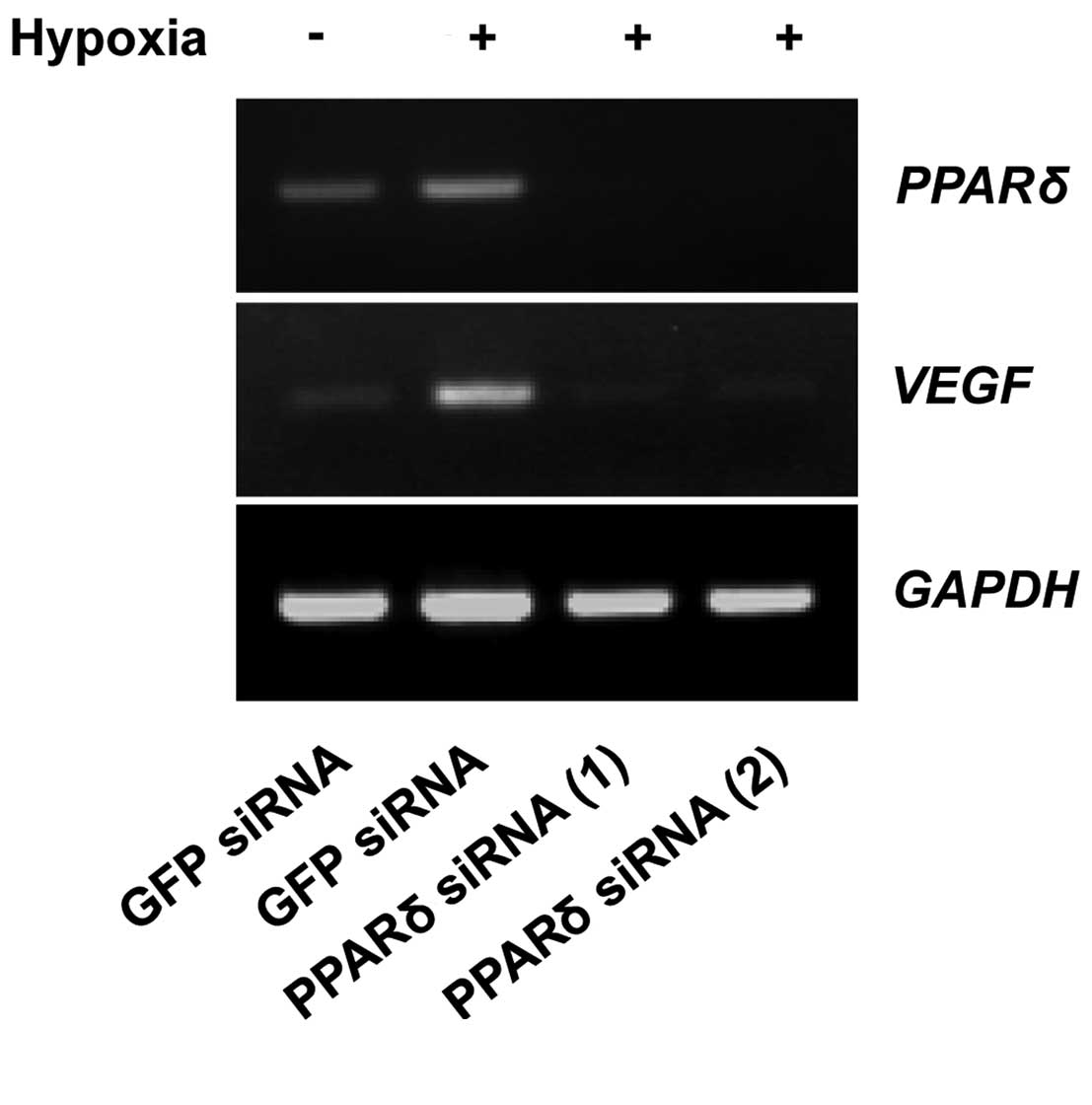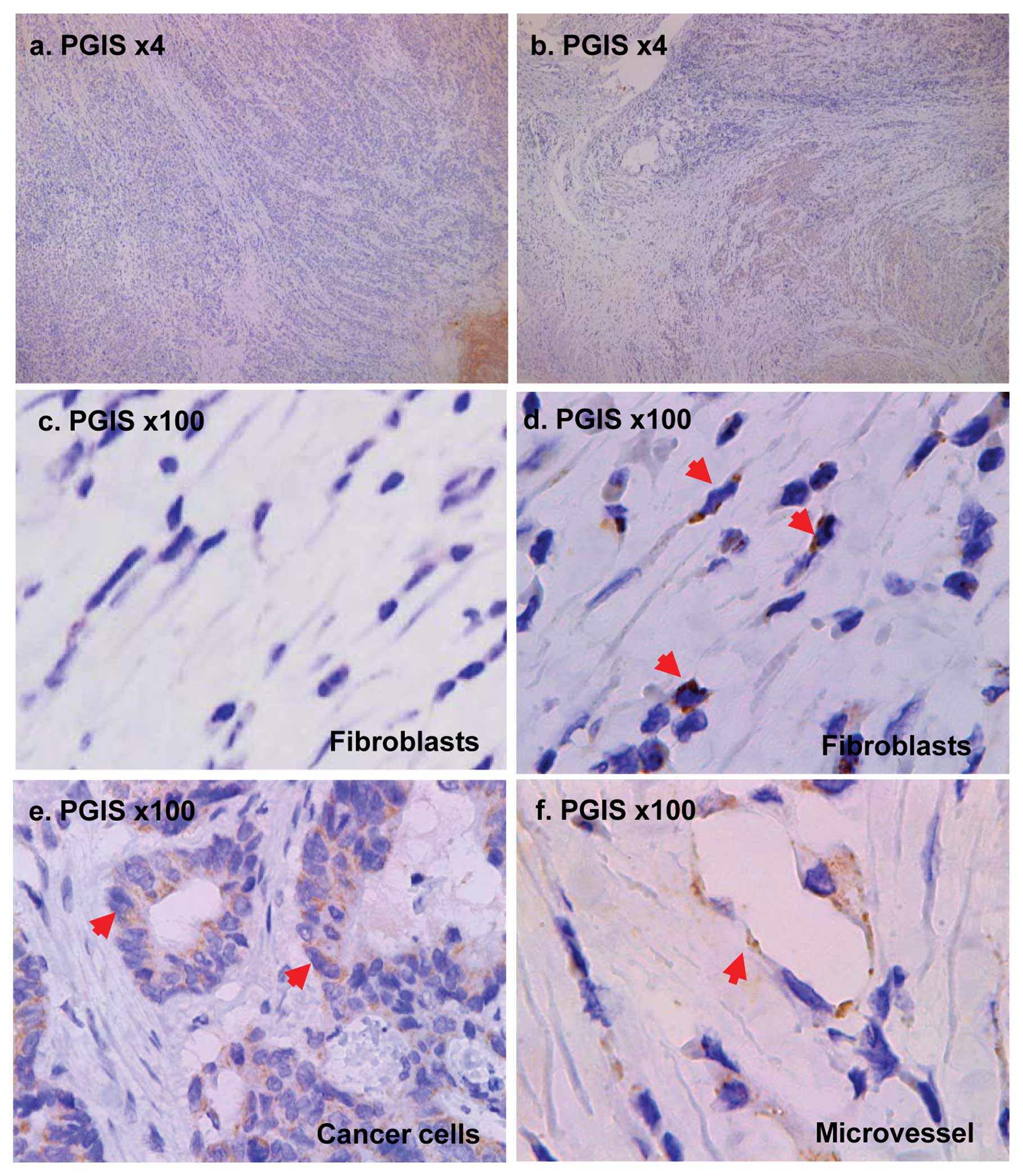VEGF expression is augmented by hypoxia‑induced PGIS in human fibroblasts
- Authors:
- Published online on: June 27, 2013 https://doi.org/10.3892/ijo.2013.1994
- Pages: 746-754
Abstract
Introduction
Cancer is subject to a unique microenvironment, composed of cancer cells, cancer-associated stromal fibroblasts (CAFs), endothelial cells, inflammatory cells and abundant extracellular matrix (1). It has been hypothesized that the components besides cancer cells in cancer tissues are functionally organized to promote survival of cancer cells against hypoxia in the host and generate a favorable microenvironment for cancer cells in both primary and metastatic sites (2). CAFs in the tumor stroma are involved in all stages of tumor development. A previous study has shown that fibroblasts from cancer mass produce PGI2 but fibroblasts from adjacent normal tissues do not (3). However, how CAFs are activated to produce PGI2 and if the activated CAFs can promote angiogenesis by generating VEGF itself are poorly understood.
We investigated the modulation of the gene expression in human fibroblasts under hypoxic condition using GeneChip analysis, and found that the expression of prostacyclin synthase (PGIS) was upregulated. PGIS, a membrane-bound heme protein with spectral characteristics of cytochrome p450 (CYP), is also an enzyme which catalyzes the conversion of prostaglandin H2 (PGH2) to form prostacyclin (PGI2). PGIS is localized to the microsomal fractions of platelets, vascular endothelial cells, and vascular smooth muscle cells (4–8). PGIS-deficient mice generated by gene targeting are associated with thickening of arterial walls, interstitial fibrosis with nephrosclerosis and kidney infarction (9). Interestingly, some groups reported that PGI2, the product of PGIS, promotes colorectal cancer growth probably by activating peroxisome proliferator-activated receptor δ (PPARδ) (10). Inhibition of COX-2-derived prostacyclin (PGI2) induces colon cancer cell apoptosis (11). PGI2 also regulates the transcription of VEGF by PPARδ (12,13).
In the present study, we focused our study on PGIS and confirmed that the expression of PGIS was upregulated in human fibroblasts under hypoxic condition and the induced PGIS was involved in the induction of VEGF. We have suggested that PPARδ enhances the hypoxic induction of VEGF.
Materials and methods
Antibodies
The polyclonal antibody against PGIS was purchased from Cayman. The polyclonal antibody against Erk-1 was purchased from Santa Cruz Biotechnology (Santa Cruz, CA). The monoclonal antibody against GAPDH was purchased from Ambion Inc. (Austin, TX).
Patients
The paraffin specimens of 3 cases of colon cancer were supplied from Department of Surgical Oncology Kagoshima University Faculty of Medicine. This study was performed with the approval of the Ethics Committee for Epidemiological Studies in Kagoshima University Graduate School of Medical and Dental Sciences.
Cell lines and cell cultures
WI-38 and TIG-3-20 human fibroblasts were purchased from Health Science Research Resources Bank (HSRRB), human embryonic lung fibroblasts (HEL) and human neuroblastoma cells (NB-1) cell lines were provided from Professor Y. Eizuru (Kagoshima University, Kagoshima, Japan) and Professor A. Tomoda (Tokyo Medical University, Tokyo, China), respectively. Other cell lines were stocked in our laboratory. All of the cells were cultured in Dulbecco’s modified Eagle’s medium (DMEM) containing 10% FCS, 2 mM glutamine and 100 U/ml penicillin at 37°C in a 5% CO2 humidified atmosphere. Hypoxic condition was induced by incubating the cells in a Personal Multigas Incubator (Astec) at 37°C with humidified 1% O2.
GeneChip analysis
cDNA and biotinylated cRNA were synthesized according to the standard protocols provided by Affymetrix (Santa Clara, CA). Biotinylated cRNA were purified using the Sample Cleanup Module (Affymetrix), and subsequently hybridized, according to the manufacturer’s standard protocols, to Affymetrix HGU133A GeneChips (which contain 22283 probe sets). Arrays were scanned using an Affymetrix confocal laser scanner. A gene expression analysis software program, GeneSpring, version 7.1 (Agilent), was used to perform statistical analysis.
Reverse transcription-PCR
1 μg first-strand cDNA was used for each polymerase chain reaction (PCR). The human PGIS primers were as follows: forward, 5′-ctggctcctgc tcttccttctcaag-3′; reverse, 5′-caccacgtcgcaggttgaattcttg-3′. The human VEGF primers were: forward, 5′-tgtcttgggtgcattggag ccttgc-3′; reverse, 5′-gttgtgctgtaggaagctcatctctc-3′. The human GAPDH primers for internal control were: forward, 5′-tgcacc accaactgcttag-3′; reverse, 5′-gaggcagggatgatgttc-3′. The human PPARδ primers were: forward, 5′-actgagttcgccaagagcatc-3′; reverse, 5′-aacgttcatgaggcctggccg-3′.
The PCR amplification mixture was adjusted to a final volume of 20 μl. Twenty-eight cycles were performed at 94°C for 30 sec for denaturation, 58°C for 30 sec for annealing, and 72°C for 30 sec for extension. The PCR products were separated on 1.5% agarose gel and then stained with ethidium bromide.
Real-time reverse transcription-PCR quantification
Total cellular RNA was extracted using TRIzol reagent according to the manufacturer’s instructions (Invitrogen, Carlsbad, CA). One microgram of RNA was reverse transcribed using a first-strand cDNA synthesis kit (ReverTra Ace-α-, Toyobo, Osaka, Japan). The set of SYBR Premix Ex Taq kit was purchased from Takara Bio (Shiga, Japan). Human PGIS, VEGF, GAPDH gene expression levels were assayed by real-time reverse PCR (PRISM 7900HT, Applied Biosystems, Foster City, CA) according to the technical brochure of the company. Human GAPDH was used for normalization. Quantification of target gene expression was obtained with the comparative cycle threshold method according to the instructions of the manufacturer (Applied Biosystems). All experiments were performed in triplicate for each data point. Each quantitation was performed with the standard curve method.
Protein extraction and immunoblot analysis
Cells were harvested and lysed with RIPA buffer [50 mM Tris-HCI (pH 7.4), 150 mM NaCl, 1 mM EGTA, 1 mM EDTA, 20 mM NaF, 100 mM Na3VO4, 0.5% Nonidet P-40 (NP-40), 1% Triton X-100, 1 mM PMSF, DTT, aprotinin, APMSF and protease inhibitor cocktail (Sigma)]. The lysates were passed through a 21-gauge needle to break up the cell aggregates and were cleared by centrifugation at 14,000 × g for 15 min at 4°C; the supernatant (total cell lysate) was immediately used or stored at −80°C until use.
Lysates were subjected to 9.4% SDS-polyacrylamide gel electrophoresis (SDS-PAGE), and then were transferred to polyvinylidene difluoride membranes (Immobilon-P transfer membrane; Millipore, Bedford, MA). The membrane was treated with buffer A [350 mM NaCl, 10 mM Tris-HCl (pH 8.0), and 0.05% Tween-20] containing 3% skimmed milk for 1 h and incubated with the indicated antibody (1:1,000) in buffer A containing 3% skimmed milk for 1 hour. Following four washes with buffer A (10 min each), the membrane was incubated with a peroxidase-conjugated horse anti-mouse IgG diluted 1:1,000 in buffer A containing 3% skimmed milk for 1 hour. The membrane was washed with buffer A and developed using the enhanced chemiluminescence western blot analysis detection system (Amersham Biosciences, Buckinghamshire, UK).
Subcellular fractionation
Cells were washed with PBS and then resuspended in 3 volumes of buffer B [10 mM HEPES-KOH (pH 7.8), 10 mM KCl, 0.1 mM EDTA (pH 8.0), 1 μg/ml aprotinin and 1 mM p-aminophenyl methanesulfonyl fluoride]. The cells were disrupted by dounce homogenizer. The nuclear fractions were centrifuged at 13,000 rpm for 5 min at 4°C. The supernatant was used as cytosolic fractions.
Inhibition of PGIS and PPARδ expression by small interfering RNA
Specific small interfering RNA (siRNA) of PGIS was purchased from Santa Cruz Biotechnology. SiRNA duplexes of PPARδ were synthesized using the Silencer™ siRNA construction kit (Ambion Inc.). The siRNA used in this study consisted of a 21-nucleotide sense strand and a 21-nucleotide antisense strand with a two-nucleotide overhang at 3′-end. The sequences were: PPARδ-siRNA(1) sense 5′-CAUGGAGUGCCGGGUGUG CUU-3′ starting at nucleotide 211 from AUG start codon of human PPARδ coding sequence. PPARδ-siRNA(1) antisense, 5′-GCACACCCGGCACUCCAUGUU-3′. PPARδ-siRNA(2) sense 5′-GCUGGAGUACGAGAAGUGUUU-3′ starting at nucleotide 313 from AUG start codon of human PPARδ coding sequence. PPARδ-siRNA(2) antisense, 5′-ACACUUCUCG UACUCCAGCUU-3′.
Transfections were accomplished using Lipofectamine 2000 (Invitrogen), according to the manufacturer’s protocol. After transfection, the cells were incubated under normoxic condition for 5 h, then changed with fresh DMEM and incubated under hypoxic condition until harvested at different time points. The effect of the siRNA on the expression of PGIS and VEGF was assessed using RT-PCR and real-time PCR, as described above.
6-Keto-prostaglandin F1α enzyme immunoassay
6-Keto-prostaglandin F1α (stable hydrolysis product of PGI2) was analyzed by specific enzyme immunoassay kit (EIA) (Assay Designs), following the manufacturer’s instructions. Lysates were added to every well of the kit plate. The resulting values of 6-keto-prostaglandin F1α concentrations in the supernatant were normalized for lyses buffer.
Confocal fluorescence microscopy
WI-38 and HEL cells were cultured under normoxic or hypoxic condition for different time, and fixed with 4% paraformaldehyde (PFA) in PBS for 30 min at room temperature. After blocking with 5% normal goat serum in PBS/0.02% Tween-20, the cells were incubated with an antibody against PGIS (1:100) at 4°C overnight. After washing thrice in PBS/0.02% Tween-20, the cells were incubated with secondary antibodies (anti-rabbit-FITC 1×100). Nuclei were stained by incubating cells with 6 μmol/l 4′6-diamidino-2-phenylindole (DAPI). The cells were observed using confocal fluorescence microscopy (FV500, Olympus Corporation).
Immunohistochemistry
Immunohistochemical studies for PGIS and HIF-1α were performed on formalin-fixed, paraffin-embedded surgical sections obtained from patients with colorectal cancer. Slides were deparaffinized in xylene and rehydrated in a graded alcohol series. To retrieve antigen, sections were heated in the citrate buffer pH 6.0 (Target retrieval solution, S1699, Dako, Carpinteria, CA) for 5 min at 121°C by means of an autoclave. For detection and visualization, the retrieved antigens were reacted with the appropriate specific primary antibodies solution (diluted to 1:100) for 1 h and were visualized by means of a polymer method (ChemMate Envision, K5027, Dako) and colorimetric diaminobenzidine (DAB)-peroxide (H2O2) reaction (DAB+ liquid system, K3468, Dako). Nuclear counterstaining was hematoxylin (ChemMate hematoxylin, S2020, Dako). These procedures were performed by an autostainer (Autostainer, Dako) with rinsing buffer warmed at 35°C (14).
Results
GeneChip analysis
GeneChip analysis was used for identifying the modulation of the gene expression in fibroblasts under hypoxic condition. A total of 234 genes were differentially expressed between fibroblasts under normoxic or hypoxic condition in this study. Relative to normoxic condition data profiling, 172 genes were upregulated and 62 genes were downregulated (3-fold change). Of 172 upregulated genes, genes related to tumor metastasis, endothelial cell biology and TGF-β signaling pathway etc. were included. Table I lists some upregulated genes in fibroblasts under hypoxic condition. Among these genes, we focused on PGIS, which showed 13.5-fold increased expression levels.
Table IGeneChip analysis of the modulation of the gene expression in fibroblasts under hypoxic condition. |
Expression of mRNA for PGIS proteins determined by RT-PCR or real-time qualitative PCR
As shown in Fig. 1A, the expression levels of PGIS gene were significantly enhanced in fibroblasts such as WI-38, TIG-3-20 and HEL time-dependently under hypoxic condition. To quantitate the mRNA expression levels of PGIS in fibroblasts, real-time quantitative RT-PCR was performed (Fig. 1B). Moreover, the expression levels of PGIS in some human cancer cells were also investigated in this study. The time-dependently enhanced expression levels of PGIS under hypoxic condition were detected in human neuroblastomas (NB-1) (Fig. 1A and B) and human melanomas (G361), but not in glioblastomas (U251MG), pancreas cancer (MiapacaII), non-small cell lung cancer (A549), KB/TP and EJ/TP cells (15) (data not shown). PGIS mRNA was not detected in human macrophages (U937 and THP1) under normoxic or hypoxic condition (data now shown). Since the enhanced expression levels of PGIS were not detected in fibroblasts cultured in the medium containing 1% FCS (data not shown), the induction of PGIS could not be attributed to the low nutrient condition. These results suggested that the enhanced expression of PGIS mRNA in fibroblasts and some cancer cells was induced by hypoxic condition.
Expression and intracellular localization of PGIS in fibroblasts and neuroblastomas
We next examined expression levels of PGIS in fibroblasts (HEL) and neuroblastomas (NB-1) by western blot analysis (Fig. 1C). Expression levels of PGIS protein in both cell lines were also enhanced time-dependently under hypoxic condition consistent with mRNA level. To identify the subcellular localization of PGIS induced by hypoxia, PGIS was observed using confocal fuorescence microscopy. As shown in Fig. 2A, the expressions of PGIS were mainly localized in the cytoplasm of WI-38 cells, and translocated to nuclei under hypoxic condition. Immunoblot analysis also showed that PGIS was translocated from cytoplasm to nuclei when the cells were cultured under hypoxic condition (Fig. 2B).
The effect of PGIS knockdown on the induction of VEGF under hypoxic condition in fibroblasts
PGI2 is known to increase the expression levels of the pro-angiogenic factor VEGF (16,17). To confirm that PGIS is involved in the enhanced expression of VEGF under hypoxic condition in fibroblasts, PGIS siRNA was used to knockdown the expression of PGIS. The induction of PGIS mRNA expression by hypoxia was considerably suppressed by PGIS siRNA (Fig. 3A). PGIS knockdown resulted in the decreased expression of VEGF mRNA (Fig. 3B). These results show that PGIS is required for the hypoxic induction of VEGF.
Expression of 6-keto-prostaglandin F1α in HEL and NB-1 cells under hypoxic condition
Since PGI2 is unstable, the level of the stable hydrolysis metabolite of PGI2, 6-keto-prostaglandin F1α was analyzed in HEL and NB-1 cells under hypoxic condition. The level of 6-keto-prostaglandin F1α was also significantly increased in a time-dependent manner under hypoxic condition compared with that under normoxic condition (p<0.05, triplicate determinations; Fig. 3C).
The effect of PPARδ-targeting siRNAs on the expression of VEGF under hypoxic condition
It was previously reported that endogenous PGI2 generation by co-expression of COX-2 and PGIS activated PPARδ (18). Because the expression of COX-2 was not induced under hypoxic condition in fibroblasts and tumor cells (data not shown), we considered that PGI2 produced by the hypoxia-induced PGIS entered the nuclei and interacted with PPARδ.
To examine whether PPARδ regulates the expression of VEGF, WI-38 cells transfected with PPARδ siRNA or green fluorescent protein (GFP) siRNA as a control were cultured under hypoxic condition. As shown in Fig. 4, downregulation of PPARδ suppressed the expression of VEGF mRNA. These results indicate that PPARδ regulates transcription of VEGF in WI-38 cells.
Expression of PGIS in clinical patients by immunohistochemistry
To determine whether PGIS is expressed in fibroblasts and cancer cells in clinical human tumor tissues, we examined 3 cases of human colon cancer tissues. As shown in Fig. 5, PGIS was expressed in cancer cells and fibroblasts which are located in the deep layers of the intestinal wall but not in the surface layers (Fig. 5a–b). Immunohistochemical staining of PGIS validated the induced expression of PGIS in fibroblasts under hypoxic condition in tumors (Fig. 5d).
Discussion
In this study, we observed the induction of PGIS expression under hypoxic condition, and confirmed that the induced PGIS was, at least in part, responsible for the increased expression of VEGF in human fibroblasts. We showed that PGIS was induced in fibroblasts and cancer cells by hypoxia, but not in cells under low nutrient condition (Fig. 1).
PGIS was accumulated in the nuclei of fibroblasts under hypoxia, and the amount of 6-keto-PGF1α was increased with increasing expression of PGIS, suggesting that PGI2 was produced by the induced PGIS.
We considered that the increased PGI2 was caused by the hypoxia-induced PGIS, since the expression of COX-2 was not induced under hypoxic condition in both fibroblasts and tumor cells (data not shown). PGI2 has been shown to be a ligand for peroxisomal-proliferator-activated receptors (PPAR). It was previously reported that endogenous PGI2 generation by co-expression of COX-2 and PGIS led to transcriptional activation of PPARδ (18). Increased PPARδ augmented the transcription of its target genes such as VEGF (19), PGI2 is also known to increase the expression of VEGF in cultured lung fibroblasts (17). PGI2 seems to play an important role in generating VEGF and consequently angiogenesis and tumor growth. Therefore, we investigated VEGF expression in fibroblasts under hypoxic condition. VEGF was time-dependently induced under hypoxic condition in a manner similar to PGIS. Downregulation of PGIS suppressed the increased expression of VEGF under hypoxic condition, indicating that PGIS is involved in the regulation of VEGF expression under hypoxic condition (Figs. 3A, B and 4). These results suggest that PGIS locates upstream of the VEGF gene in agreement with previous results (12,13).
The pro-angiogenic factor VEGF overexpressed in most cancer cells is part of the system that restores oxygen supply to tumor tissues when blood circulation is inadequate (20). It is generally accepted that VEGF recruited by cancer cells acts on cancer mesenchyme-like endothelial and inflammatory cells to cause angiogenesis. VEGF induced by PGIS in fibroblasts under hypoxic condition may play an important role in the progression of carcinomas.
Moreover, the main localization of PGIS changed from cytoplasm to nuclei by hypoxia in human fibroblast cells (Fig. 2). This finding suggested that PGIS itself may enter the nuclei, where it synthesizes PGI2 to regulate the expression of VEGF (Fig. 6). The mechanism of this nuclear translocation of PGIS remains to be uncovered.
Finally, the immunostaining patterns of tumors from clinical cancer patients were in accord with the data obtained from in vitro experiments (Fig. 5). The PGIS-positive cancer cells and fibroblasts were only detected in the deep layers of the intestinal wall where is thought to be deficient in oxygen but not in the surface layers. These findings might support the view that PGIS is involved in tumor progression and angiogenesis under hypoxic condition. PGI2 was previously shown to activate PPARδ leading to subsequent acceleration in intestinal tumor growth in ApcMin/+ mice (21). Meanwhile, PGI2-mediated activation of PPARδ was implicated in negative growth of lung cancer cell lines (22). The role of PGIS in tumor growth might be different in respective cells.
Transcriptional regulation of the PGIS gene has rarely been reported in the literature. Recently, Camacho et al defined the minimal PGIS promoter region responsive to hypoxia. However, it did not contain a putative hypoxia responsive element (HRE). Furthermore, they observed that knockdown of HIF-1α abrogated hypoxia-induced PGIS upregulation in human vascular cells, and suggested that PGIS transcriptional activity enhanced by hypoxia could be the results of the cooperative binding of several transcription factors to PGIS promoter (23). Further study is needed to elucidate the molecular basis for the induction of PGIS by hypoxia.
In conclusion, this study provides new and important information about PGIS induced in fibroblasts under hypoxic condition. Since PGIS is involved in the enhanced expression of VEGF under hypoxic condition in human fibroblasts, PGIS may be a novel target for antitumor angiogenesis therapy.
Acknowledgements
We thank Professor Akio Tomoda of Tokyo Medical University for providing NB-1 cells; Professor Shoji Natsugoe of Kagoshima University for human coloncancer paraffin block; Dr Hiroshi Shirahama, Dr Yukie Tashiro, Mr. Keishi Tokunagana, Ms. Yasuko Shinmura of Imakiire General Hospital for preparing good paraffin sections from the archival paraffin block specimens; and Ms. Hiromi Mitsuo and Ms. Naomi Nakanishi for valuable secretarial assistance.
References
|
Nakagawa H, Liyanarachchi S, Davuluri RV, Auer H, Martin EW Jr, de la Chapelle A and Frankel WL: Role of cancer-associated stromal fibroblasts in metastatic colon cancer to the liver and their expression profiles. Oncogene. 23:7366–7377. 2004. View Article : Google Scholar : PubMed/NCBI | |
|
Fidler IJ: The pathogenesis of cancer metastasis: the ‘seed and soil’ hypothesis revisited. Nat Rev Cancer. 3:453–458. 2003. | |
|
Cutler NS, Graves-Deal R, LaFleur BJ, Gao Z, Boman BM, Whitehead RH, Terry E, Morrow JD and Coffey RJ: Stromal production of prostacyclin confers an antiapoptotic effect to colonic epithelial cells. Cancer Res. 63:1748–1751. 2003.PubMed/NCBI | |
|
Ingerman-Wojenski C, Silver MJ, Smith JB and Macarak E: Bovine endothelial cells in culture produce thromboxane as well as prostacyclin. J Clin Invest. 67:1292–1296. 1981. View Article : Google Scholar : PubMed/NCBI | |
|
Moncada S, Gryglewski R, Bunting S and Vane JR: An enzyme isolated from arteries transforms prostaglandin endoperoxides to an unstable substance that inhibits platelet aggregation. Nature. 263:663–665. 1976. View Article : Google Scholar | |
|
Moncada S, Herman AG, Higgs EA and Vane JR: Differential formation of prostacyclin (PGX or PGI2) by layers of the arterial wall. An explanation for the anti-thrombotic properties of vascular endothelium. Thromb Res. 11:323–344. 1977. View Article : Google Scholar : PubMed/NCBI | |
|
Ullrich V, Castle L and Weber P: Spectral evidence for the cytochrome P450 nature of prostacyclin synthetase. Biochem Pharmacol. 30:2033–2036. 1981. View Article : Google Scholar : PubMed/NCBI | |
|
Weksler BB, Ley CW and Jaffe EA: Stimulation of endothelial cell prostacyclin production by thrombin, trypsin, and the ionophore A 23187. J Clin Invest. 62:923–930. 1978. View Article : Google Scholar : PubMed/NCBI | |
|
Yokoyama C, Yabuki T, Shimonishi M, Wada M, Hatae T, Ohkawara S, Takeda J, Kinoshita T, Okabe M and Tanabe T: Prostacyclin-deficient mice develop ischemic renal disorders, including nephrosclerosis and renal infarction. Circulation. 106:2397–2403. 2002. View Article : Google Scholar | |
|
Gupta RA, Tan J, Krause WF, Geraci MW, Willson TM, Dey SK and DuBois RN: Prostacyclin-mediated activation of peroxisome proliferator-activated receptor delta in colorectal cancer. Proc Natl Acad Sci USA. 97:13275–13280. 2000. View Article : Google Scholar : PubMed/NCBI | |
|
Wu KK and Liou JY: Cyclooxygenase inhibitors induce colon cancer cell apoptosis via PPARdelta → 14-3-3epsilon pathway. Methods Mol Biol. 512:295–307. 2009.PubMed/NCBI | |
|
Arany Z, Foo SY, Ma Y, Ruas JL, Bommi-Reddy A, Girnun G, Cooper M, Laznik D, Chinsomboon J, Rangwala SM, Baek KH, Rosenzweig A and Spiegelman BM: HIF-independent regulation of VEGF and angiogenesis by the transcriptional coactivator PGC-1alpha. Nature. 451:1008–1012. 2008. View Article : Google Scholar : PubMed/NCBI | |
|
Mizukami Y, Li J, Zhang X, Zimmer MA, Iliopoulos O and Chung DC: Hypoxia-inducible factor-1-independent regulation of vascular endothelial growth factor by hypoxia in colon cancer. Cancer Res. 64:1765–1772. 2004. View Article : Google Scholar : PubMed/NCBI | |
|
Wang J, Hasui K, Jia X, Matsuyama T and Eizuru Y: Possible role for external environmental stimuli in nasopharyngeal NK/T-cell lymphomas in the northeast of China with EBV infection-related autophagic cell death: a pathoepidemiological analysis. J Clin Exp Hematop. 49:97–108. 2009. View Article : Google Scholar | |
|
Nakajima Y, Gotanda T, Uchimiya H, Furukawa T, Haraguchi M, Ikeda R, Sumizawa T, Yoshida H and Akiyama S: Inhibition of metastasis of tumor cells overexpressing thymidine phosphorylase by 2-deoxy-L-ribose. Cancer Res. 64:1794–1801. 2004. View Article : Google Scholar : PubMed/NCBI | |
|
Buchanan FG, Chang W, Sheng H, Shao J, Morrow JD and DuBois RN: Up-regulation of the enzymes involved in prostacyclin synthesis via Ras induces vascular endothelial growth factor. Gastroenterology. 127:1391–1400. 2004. View Article : Google Scholar : PubMed/NCBI | |
|
Kamio K, Sato T, Liu X, Sugiura H, Togo S, Kobayashi T, Kawasaki S, Wang X, Mao L, Ahn Y, Holz O, Magnussen H and Rennard SI: Prostacyclin analogs stimulate VEGF production from human lung fibroblasts in culture. Am J Physiol Lung Cell Mol Physiol. 294:L1226–L1232. 2008. View Article : Google Scholar : PubMed/NCBI | |
|
Tong BJ, Tan J, Tajeda L, Das SK, Chapman JA, DuBois RN and Dey SK: Heightened expression of cyclooxygenase-2 and peroxisome proliferator-activated receptor-delta in human endometrial adenocarcinoma. Neoplasia. 2:483–490. 2000. View Article : Google Scholar | |
|
Piqueras L, Reynolds AR, Hodivala-Dilke KM, Alfranca A, Redondo JM, Hatae T, Tanabe T, Warner TD and Bishop-Bailey D: Activation of PPARbeta/delta induces endothelial cell proliferation and angiogenesis. Arterioscler Thromb Vasc Biol. 27:63–69. 2007. View Article : Google Scholar : PubMed/NCBI | |
|
Moreira IS, Fernandes PA and Ramos MJ: Vascular endothelial growth factor (VEGF) inhibition - a critical review. Anticancer Agents Med Chem. 7:223–245. 2007. View Article : Google Scholar : PubMed/NCBI | |
|
Wang D, Wang H, Guo Y, Ning W, Katkuri S, Wahli W, Desvergne B, Dey SK and DuBois RN: Crosstalk between peroxisome proliferator-activated receptor delta and VEGF stimulates cancer progression. Proc Natl Acad Sci USA. 103:19069–19074. 2006. View Article : Google Scholar : PubMed/NCBI | |
|
Fukumoto K, Yano Y, Virgona N, Hagiwara H, Sato H, Senba H, Suzuki K, Asano R, Yamada K and Yano T: Peroxisome proliferator-activated receptor delta as a molecular target to regulate lung cancer cell growth. FEBS Lett. 579:3829–3836. 2005. View Article : Google Scholar : PubMed/NCBI | |
|
Camacho M, Rodríguez C, Guadall A, Alcolea S, Orriols M, Escudero JR, Martínez-González J and Vila L: Hypoxia upregulates PGI-synthase and increases PGI release in human vascular cells exposed to inflammatory stimuli. J Lipid Res. 52:720–731. 2011. View Article : Google Scholar : PubMed/NCBI |



